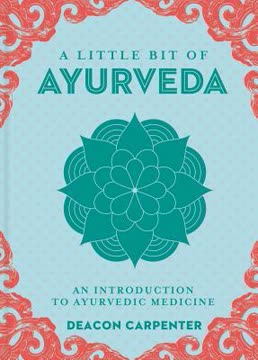Key Takeaways
1. Ayurveda: Ancient Wisdom for Modern Health
"Ayurveda provides us with clear guidelines on how to live our lives with the innate understanding of our unique mind and body types (called doshas) and how to keep them balanced through the journey of life."
Holistic approach. Ayurveda, a 5,000-year-old medical system from India, offers a comprehensive approach to health and well-being. It focuses on prevention rather than just managing symptoms, addressing the whole person - mind, body, and spirit.
Personalized medicine. Unlike one-size-fits-all approaches, Ayurveda recognizes that each person is unique. It provides tailored recommendations based on an individual's constitution (dosha) and current state of imbalance.
Practical application. Ayurvedic principles can be integrated into modern life through:
- Dietary adjustments
- Lifestyle modifications
- Stress management techniques
- Herbal remedies
- Detoxification practices
2. Understanding Your Unique Mind-Body Type (Dosha)
"Even though most of your answers may fall in the Pitta column, you may have one in Vata and two in Kapha."
Three doshas. Ayurveda categorizes individuals into three main mind-body types or doshas:
- Vata (air and space)
- Pitta (fire and water)
- Kapha (earth and water)
Unique combinations. Most people are a combination of two or more doshas, with one usually predominant. Understanding your unique constitution helps tailor health recommendations specifically for you.
Dynamic balance. Your dosha balance can shift due to factors like:
- Diet
- Lifestyle
- Stress
- Seasons
- Age
Recognizing these shifts allows you to make adjustments to maintain optimal health.
3. The Power of Digestion in Ayurvedic Health
"The digestive system is also referred to as the inner disease pathway, because it's essentially where disease pathology starts and, when our metabolism and digestion aren't functioning optimally, how disease can hitch a ride in the bloodstream as pathogenesis occurs from accumulated ama."
Agni: digestive fire. In Ayurveda, strong digestion (agni) is crucial for overall health. It's not just about breaking down food, but also about processing emotions, experiences, and sensory inputs.
Ama: toxic residue. Poor digestion leads to the formation of ama, a toxic residue that can accumulate in the body and lead to disease. Signs of ama include:
- Bad breath
- Coated tongue
- Sharp body odor
Balancing digestion. Ayurveda offers various strategies to optimize digestion:
- Eating according to your dosha
- Mindful eating practices
- Proper food combining
- Herbal supplements
- Seasonal cleansing
4. Balancing Vata: Grounding the Wind Element
"Diet and lifestyle recommendations for Vata aren't about preventing the wind from blowing; they are more about mastering the hurricane of variability and preventing the Vata from being swept up in the tornado called life."
Vata characteristics. Vata types are creative, quick-thinking, and adaptable, but prone to anxiety and instability when out of balance.
Balancing strategies:
- Establish routines and regular mealtimes
- Favor warm, cooked, and slightly oily foods
- Practice grounding exercises like yoga and meditation
- Keep warm and avoid excessive cold or dryness
- Get sufficient rest and avoid overstimulation
Key foods: Sweet, sour, and salty tastes help balance Vata. Emphasize:
- Whole grains
- Root vegetables
- Healthy oils (ghee, olive oil)
- Nuts and seeds
- Warm milk or non-dairy alternatives
5. Harmonizing Pitta: Cooling the Fire Within
"Diet and lifestyle recommendations for Pitta aren't about putting out the flames—they're more about understanding the dynamism of the fire and knowing how to use the inferno appropriately, which surprisingly isn't all the time!"
Pitta characteristics. Pitta types are driven, intelligent, and passionate, but can become irritable and overly critical when imbalanced.
Balancing strategies:
- Avoid excessive heat (both physical and emotional)
- Incorporate cooling activities like swimming
- Practice non-competitive exercises
- Cultivate patience and relaxation techniques
- Avoid skipping meals and overly spicy foods
Key foods: Sweet, bitter, and astringent tastes help balance Pitta. Emphasize:
- Cooling fruits (melons, sweet berries)
- Leafy greens
- Whole grains
- Coconut products
- Mint and cilantro
6. Nurturing Kapha: Energizing Earth and Water
"Kaphas are the protectors of families, the keepers of memories, and the holders of grudges."
Kapha characteristics. Kapha types are stable, nurturing, and loyal, but can become lethargic and resistant to change when out of balance.
Balancing strategies:
- Engage in regular, stimulating exercise
- Embrace change and new experiences
- Practice dry brushing and self-massage
- Avoid oversleeping and excessive napping
- Cultivate mental stimulation and social connections
Key foods: Pungent, bitter, and astringent tastes help balance Kapha. Emphasize:
- Light, warm, and spicy foods
- Leafy greens and bitter vegetables
- Legumes
- Spices like ginger, black pepper, and turmeric
- Honey (in moderation)
7. Stress Management: The Ayurvedic Approach
"The ability to manage and reduce our stress levels directly impacts every system in our body, starting with our digestive system."
Holistic view of stress. Ayurveda recognizes that stress affects not just the mind, but the entire body-mind system. Chronic stress can lead to dosha imbalances and disease.
Stress-reducing techniques:
- Meditation and pranayama (breathing exercises)
- Yoga asana practice
- Abhyanga (self-massage with warm oil)
- Spending time in nature
- Adopting a sattvic (pure, balanced) lifestyle
Adaptogens. Ayurvedic herbs known as adaptogens can help the body better cope with stress. Examples include:
- Ashwagandha
- Holy basil (Tulsi)
- Shatavari
8. Food as Medicine: Ayurvedic Nutrition Principles
"Food is data—it has a physical and an emotional reaction on our physiology."
Six tastes. Ayurveda recognizes six tastes, each affecting the doshas differently:
- Sweet (builds tissues, calms nerves)
- Sour (cleanses tissues, aids digestion)
- Salty (improves taste, lubricates tissues)
- Pungent (stimulates digestion, clears sinuses)
- Bitter (detoxifies, lightens tissues)
- Astringent (absorbs water, reduces inflammation)
Mindful eating. Ayurveda emphasizes not just what we eat, but how we eat:
- Eat in a calm environment
- Chew food thoroughly
- Avoid distractions while eating
- Express gratitude for your food
- Eat until 2/3 full
Seasonal eating. Adjusting your diet according to the seasons helps maintain balance and prevent dosha imbalances.
9. The Six Stages of Disease: Prevention is Key
"Water the root to enjoy the fruit."
Disease progression. Ayurveda identifies six stages of disease development:
- Accumulation
- Aggravation
- Overflow
- Relocation
- Manifestation
- Diversification
Early intervention. The first two stages occur in the digestive system and can often be reversed through diet and lifestyle changes. Recognizing early signs of imbalance is crucial for maintaining health.
Holistic treatment. Even in later stages, Ayurveda aims to address the root cause of disease, not just manage symptoms. This may involve:
- Detoxification procedures (Panchakarma)
- Herbal remedies
- Dietary adjustments
- Lifestyle modifications
- Yogic practices
10. Ayurvedic Daily Routines for Optimal Health
"Remember, it took a long time for you to go out of balance, so it's going to take some time for you to return to balance."
Dinacharya. Ayurveda recommends specific daily routines (dinacharya) to maintain balance and prevent disease. Key practices include:
- Waking early (before sunrise)
- Oil pulling and tongue scraping
- Self-massage (abhyanga)
- Meditation and pranayama
- Eating main meal at midday
- Early bedtime (by 10 PM)
Seasonal adjustments. Modify your routine based on the season and your predominant dosha to maintain balance throughout the year.
Gradual implementation. Start with small changes and gradually incorporate more Ayurvedic practices into your daily life. Consistency is key for long-term health benefits.
Last updated:
Review Summary
A Little Bit of Ayurveda receives positive reviews for its accessible introduction to Ayurvedic principles. Readers appreciate the author's clear, no-nonsense style and practical guidance for incorporating Ayurveda into daily life. Many find the book's quiz helpful in identifying their dosha and appreciate the suggestions for balancing them. While some readers desire more depth, most consider it a valuable starting point for understanding Ayurvedic concepts. The book is praised for its aesthetic appeal and gentle approach to lifestyle changes, making it an excellent resource for beginners interested in holistic wellness.
Similar Books








Download PDF
Download EPUB
.epub digital book format is ideal for reading ebooks on phones, tablets, and e-readers.




